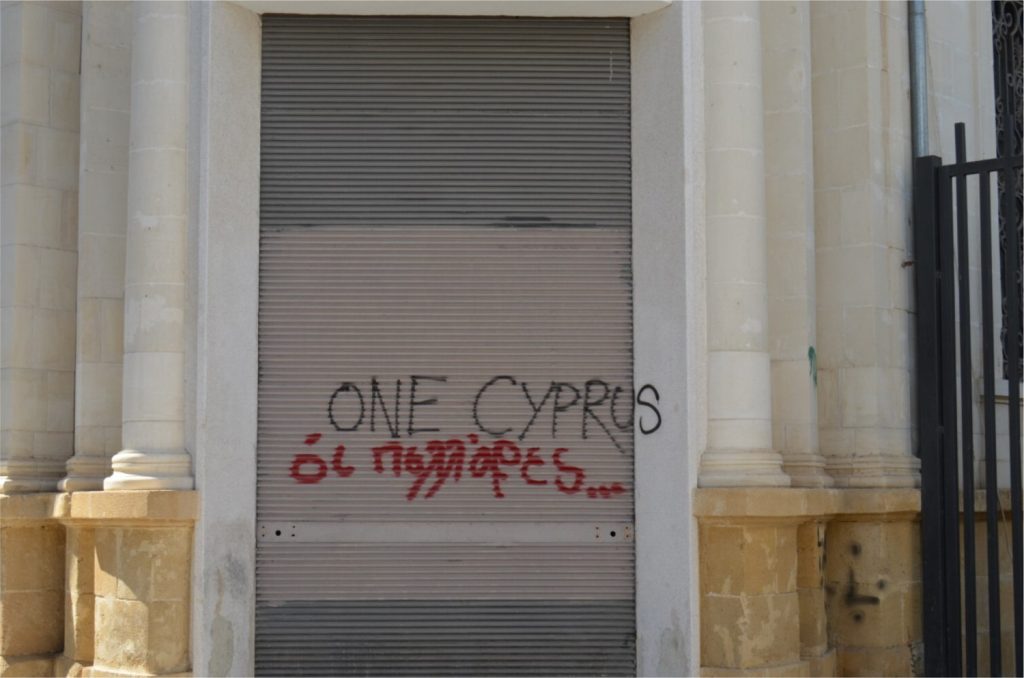Doing cross-border research
| By Christiana Themistocleous
In our book we saw many examples of ethnographic research ranging from Gumperz’s studies in India and Norway, to Eckert’s famous study of the Jocks and Burnouts, to Milroy’s study in Belfast, to Blommaert’s study of the linguistic landscape of Antwerp, and even to online ethnographic studies like those of Androutsopoulos. We said ethnographic research is very rewarding but at the same time it can be quite challenging and time-consuming (see Sociolinguist’s Toolkit).
When my co-investigator Çise Çavuşoğlu and I conducted our ethnographic study in Cyprus to explore the linguistic landscape of two borderline communities in conflict we were also faced with different kinds of challenges, especially with the walking-tour interviews. For these interviews the plan was to walk with two participants in the main commercial area in Nicosia which, due to the conflict, is divided by a UN-controlled buffer zone. Along with the participants we had to cross from the native community into the community of the ‘former’ enemy, passing through passport controls and a crossing-point which is guarded by the local police and supervised by the United Nations.
Finding participants who were willing to take part in the study was the first challenge. Due to the conflict in Cyprus and the negative attitudes towards the ‘other’, many people were not enthusiastic about crossing to the other community, either because they were scared or because of their political ideologies. I found that particularly Greek-Cypriot men, who fought during the war and who still do compulsory military service today, were the most reluctant to participate, even if I highlighted to them that the purpose of the study was to explore language in society. Because of the men’s reluctance, the majority of the Greek-Cypriot participants were women. However, this was not a huge problem for our project because gender was not the focus of this investigation.
Another challenge, in this case affecting Turkish-Cypriot participants, was that some of them were not permitted to cross to the Greek-Cypriot community. This was mainly down to the fact that they were holders of a passport that is not accepted by the Republic of Cyprus. As a result, unfortunately, some informants even if they were willing to take part in the study, were not able to do so because they were not allowed to cross to the other community.
Conducting research at the crossing point was also challenging because it is forbidden to record or take photos in that particular area. We had to explain to our participants that we need to stop the recording while going thought the passport control and start it again when we enter the other community. We were worried that our participants’ experiences and reactions to multilingual signs in that crucial area is not recorded and therefore we would miss important insights. To ensure that we obtained information about their attitudes, experiences, thoughts and reactions to the linguistic landscape while crossing the ‘border’, we asked them to stop for a moment after passing through passport control and have a quick chat about the languages they noticed around them, which signs drew their attention and why and how they felt when they saw around them the language of the ‘former enemy’.
The fieldwork was conducted in 2019 and in 2020 travel restrictions were implemented across the globe due to the COVID 19 pandemic. This meant that the crossing-point which we used for our walking-tour interviews remained closed for approximately a year and half and restrictions are still in place at the time of writing this blog post. We were lucky enough to collect all the necessary data by December 2019, namely two months before the closure of the crossing-point. If we waited longer to collect our data, then it would have been impossible to do so.
Despite the different challenges, the walking-tour interviews were a success. All the participants said that this was a positive experience which made them see the linguistic landscape in a different way, as they noticed things around them that they never did before. Those who never crossed to the other community said they found the experience enlightening as they saw for the first time how the people from the other community live and what the public space there looks like.
The data we obtained is so rich and the task to transcribe, translate and analyse the data is huge. Our preliminary analysis shows that our participants’ reactions and attitudes towards the language of the ‘other’ are not straightforward. In fact, they are so complex, ambivalent, sometimes positive, other times negative. This complexity is often attributed to people’s political ideologies. We are currently analysing these ideologies in more detail and hopefully we will share more insights soon!


Share this with
Facebook
Twitter
Email